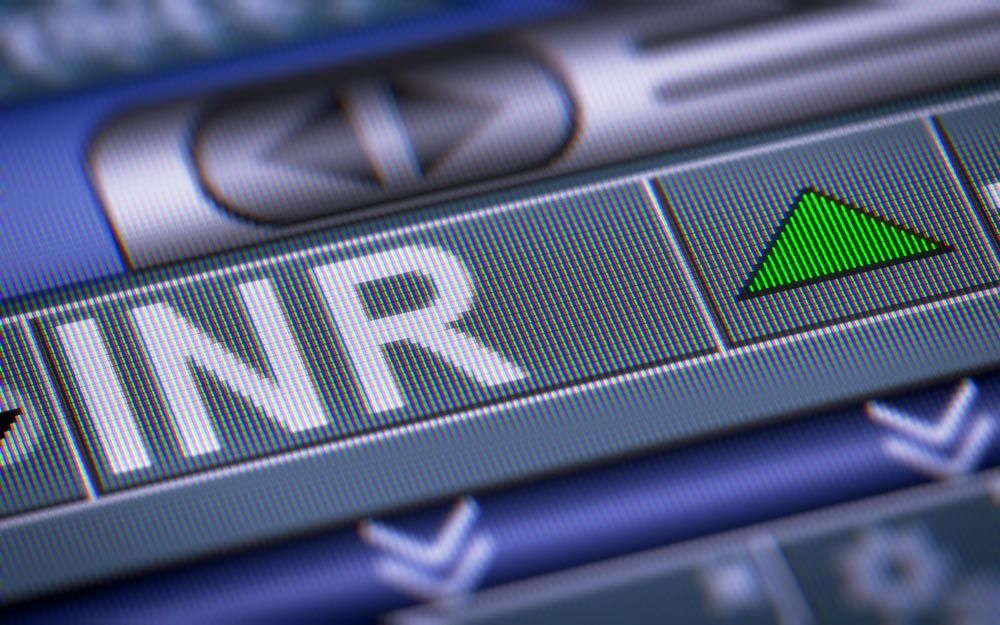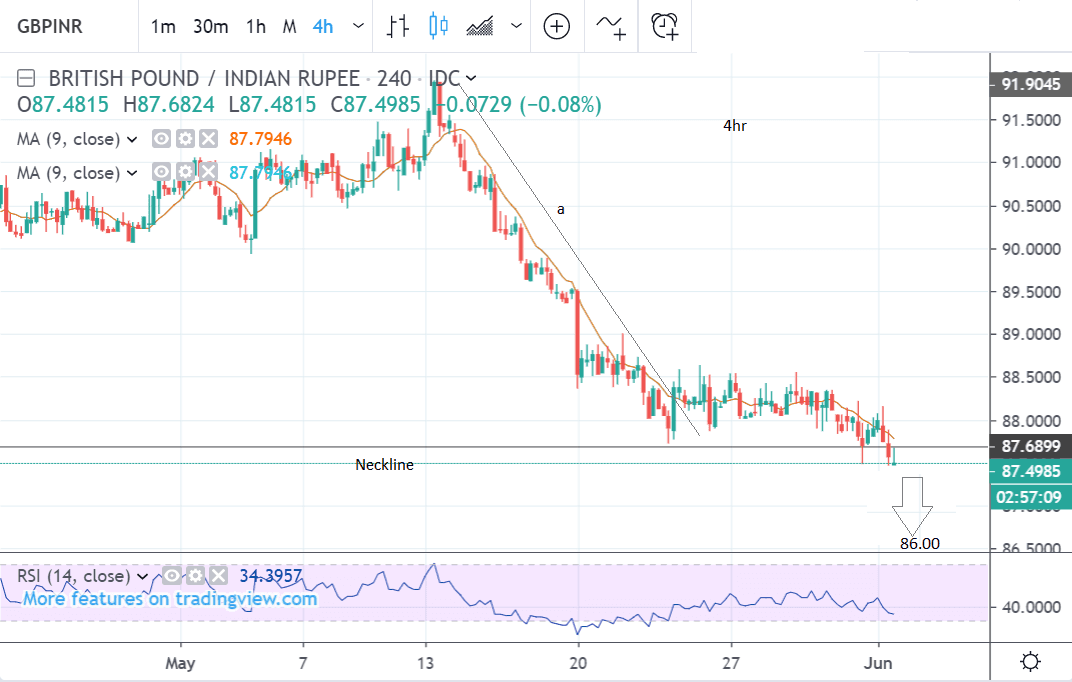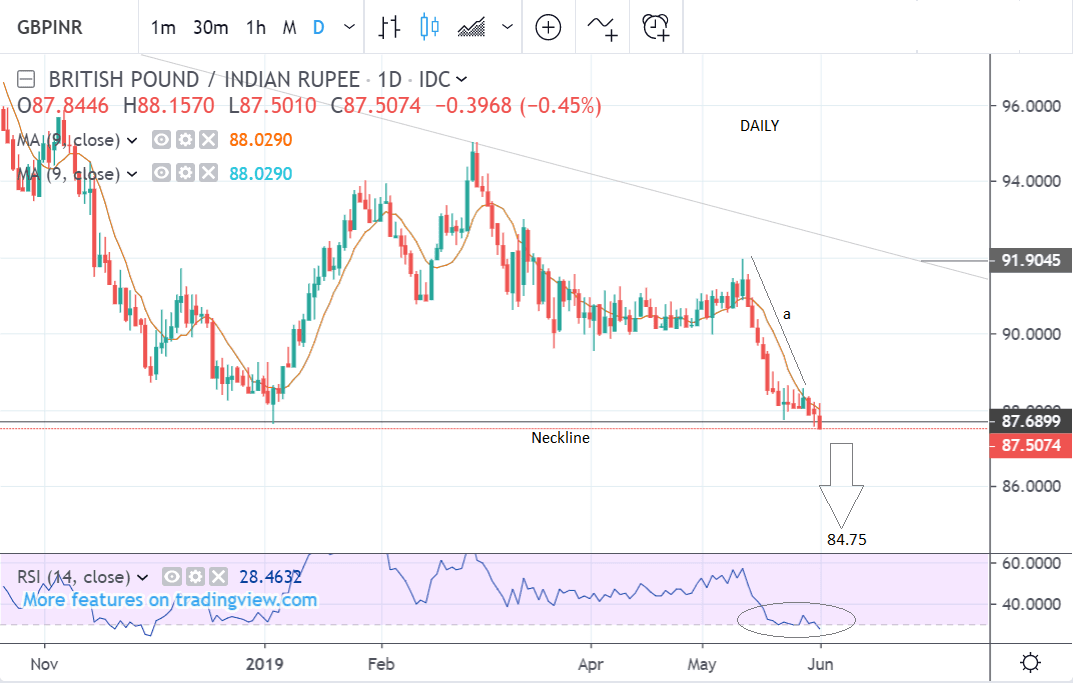Pound / Indian Rupee Rate in Process of Breaking Neckline and Descending Further

Image © Adobe Stock
- GBP/INR attempting to break below neckline of bearish pattern
- Could signal a strong bearish move lower
- Rupee eyes by RBI policy meeting
The Pound-to-Rupee exchange rate is trading at 87.54 at the start of the new week, about 0.7% lower than a week ago and studies of the charts suggest the exchange rate is set to continue its downtrend in the days ahead.
The pair is in an established downtrend on the 4hr chart which gives us an insight into the short-term outlook for the coming week. Although it recently stalled after touching a major support line, ‘the neckline’ of a large bearish pattern (see below) at around 87.70, it has now resumed its decline and threatens breaking below the neckline and beginning a new bearish phase.
This new leg lower could be as long as the ‘a’ down leg from the May 13 highs, reaching perhaps as low as 86.00 in the week ahead.
Confirmation that such a move is underway would come from a break below 87.50.
The daily chart - which gives us insights into the next 1-6 weeks - shows the same decline as part of an even longer-term bear trend stretching back to February 2019. It shows the extent to which the price is probing the neckline and trying to pierce below it.
The RSI momentum study is registering a mildly oversold reading of below 30 which suggests increased risks of a pause in the downtrend or even a pull-back.
But the pair is still likely to eventually go lower and reach the next downside target at 84.75 within a 1-6 week timeframe.
GBP/INR has formed a bearish head and shoulders (H&S) reversal pattern on the weekly chart above, which is a very negative sign. It is composed of three peaks - a head and two shoulders. A break below the neckline triggers the subsequent decline.
A break below the neckline at 87.70 would lead to a probably sell-off down to a target at 84.75 first and then possibly 80.75 eventually. The second target is roughly equal to the height of the pattern extrapolated lower, the usual method for forecasting follow-through. The second decline is likely to be hit in anywhere between 1-6 months.
Only a break above the line drawn from the peak of the pattern connected to its right shoulder at around 91.90 would invalidate its bearish potential.
The monthly chart below is included to show the reason why the 84.75 target is so important - it is just above the level of the 200-month moving average, a major support shelf likely to prop prices up.
Time to move your money? Get 3-5% more currency than your bank would offer by using the services of foreign exchange specialists at RationalFX. A specialist broker can deliver you an exchange rate closer to the real market rate, thereby saving you substantial quantities of currency. Find out more here. * Advertisement
The Rupee Eyes RBI Meeting
The main event in the week ahead for the Rupee is the policy meeting of the Reserve Bank of India (RBI), on Thursday at 10.00 BST.
The RBI cut interest rates in India from 6.5% to 6.25% in April, just before the Indian general election. RBI governor Shaktikanta Das cited reasons for the rate cut as a drop in inflation, lower oil prices and a global economic slowdown.
Lower interest rates are generally a dampener for currencies as they lower foreign capital inflows. Although the effect is less marked in the case of the Rupee because of capital controls implemented by the government to defend its currency, it can still have an impact.
Indian GDP growth was disappointing in Q1 according to recent data, rising only 5.8% compared to 6.6% in the previous quarter (compared to a year ago). This fell below estimates of 6.3%. It suggests the threat of another interest rate cut could still be on the table.
India's inflation rate (RPI) increased to 2.92% in April 2019 from 2.86% March, and although it was below market expectations of 2.97%, it was still the highest inflation rate in six months, as food prices rose the most since July last year.
A major factor influencing the Rupee over the medium and long-term is whether Narendra Modi's BJP government will push through with more favourable economic reforms after its recent landslide victory at the elections.
Assuming the BJP continues with its reform agenda the influence will be positive on the currency.
The Rupee is influenced by global risk trends like all emerging market (EM) currencies and so any worsening of the trade conflict between China and the U.S. could impact adversely on the Rupee if it spreads into a general EM rout.
China’s rhetoric is hardening versus the U.S. It recently threatened to ban exports of rare earth metals to the U.S. and has started an investigation into U.S. logistics giant Fedex, due to what it says are the volume of ‘customer complaints’.
Oil prices are a further influence on the Rupee because the country has to import most of its energy. When oil prices rise it weakens the Rupee because of the increased selling required to purchase India’s oil.
Oil prices have been in a sharp decline recently but are 1.23% higher at the start of the new week, with WTI trading at $58 per barrel. A major driver of lower prices are global growth concerns as a result of the U.S.-China trade war, which look set to rumble on indefinitely. This suggests oil prices will remain pressured for some time.
Another key driver are sanctions on Venezuela and Iran which have removed their supply from the market leading to higher prices. Sanctions are unlikely to be lifted, especially during the term of this U.S. president given his foreign policy style.
Time to move your money? Get 3-5% more currency than your bank would offer by using the services of foreign exchange specialists at RationalFX. A specialist broker can deliver you an exchange rate closer to the real market rate, thereby saving you substantial quantities of currency. Find out more here. * Advertisement


